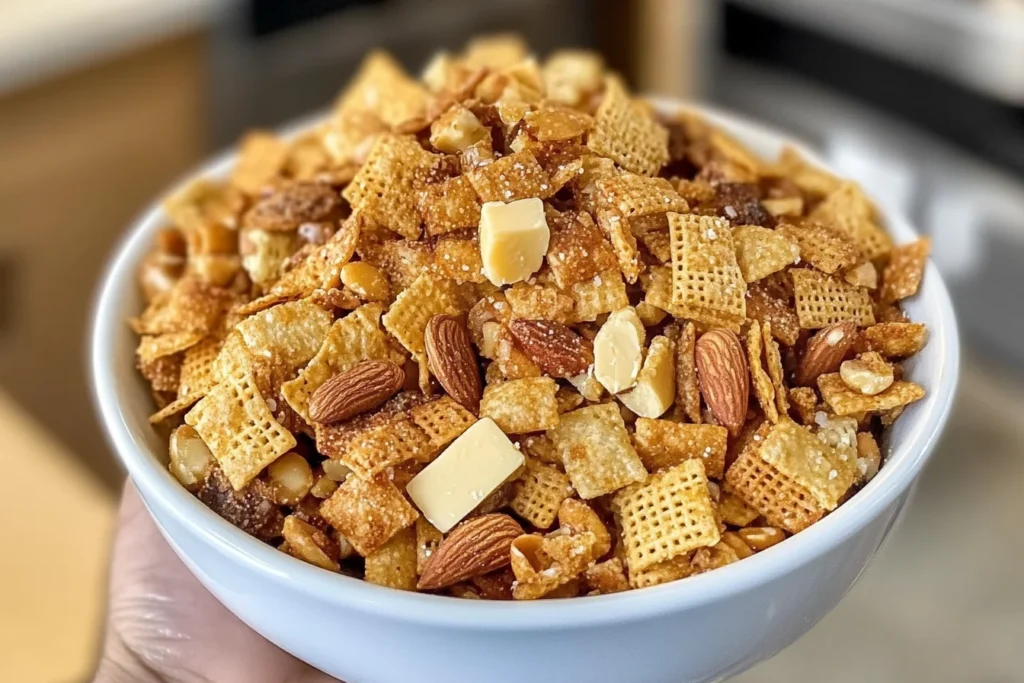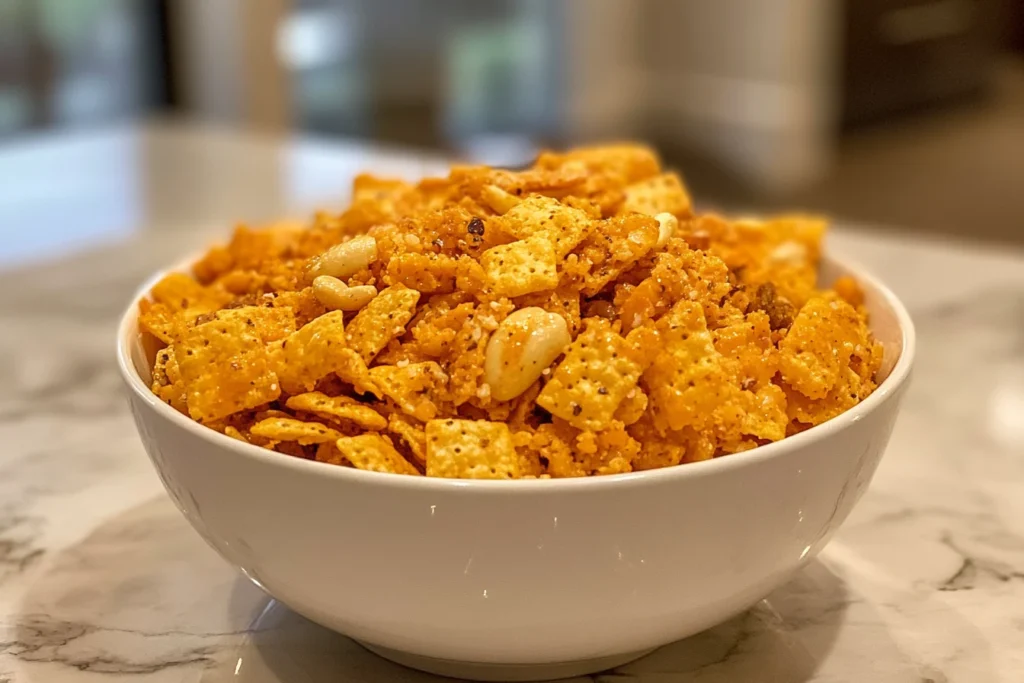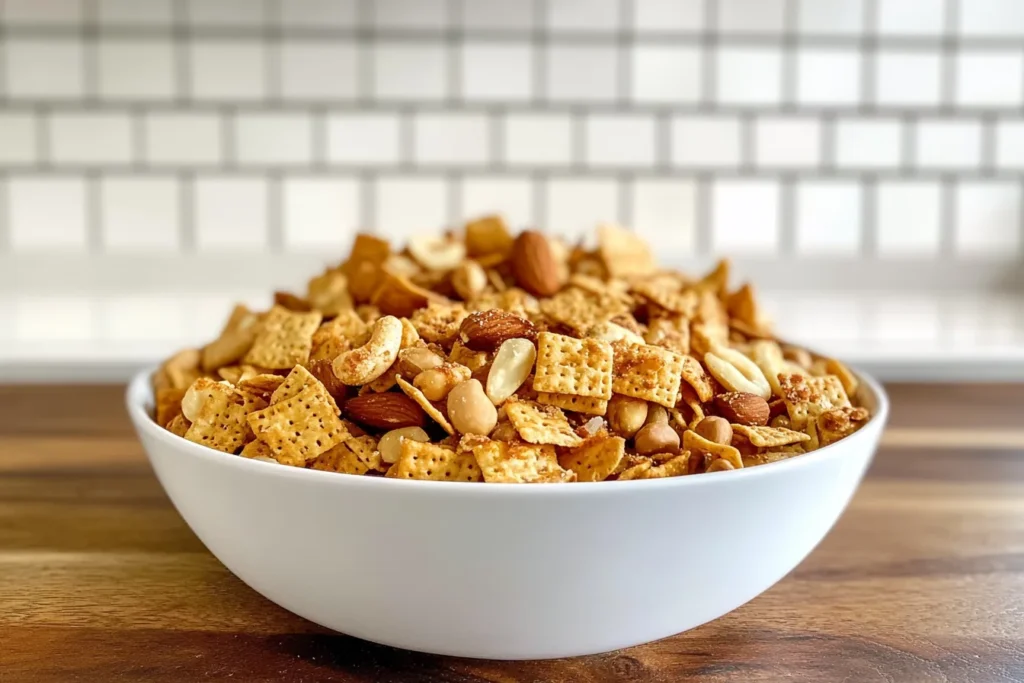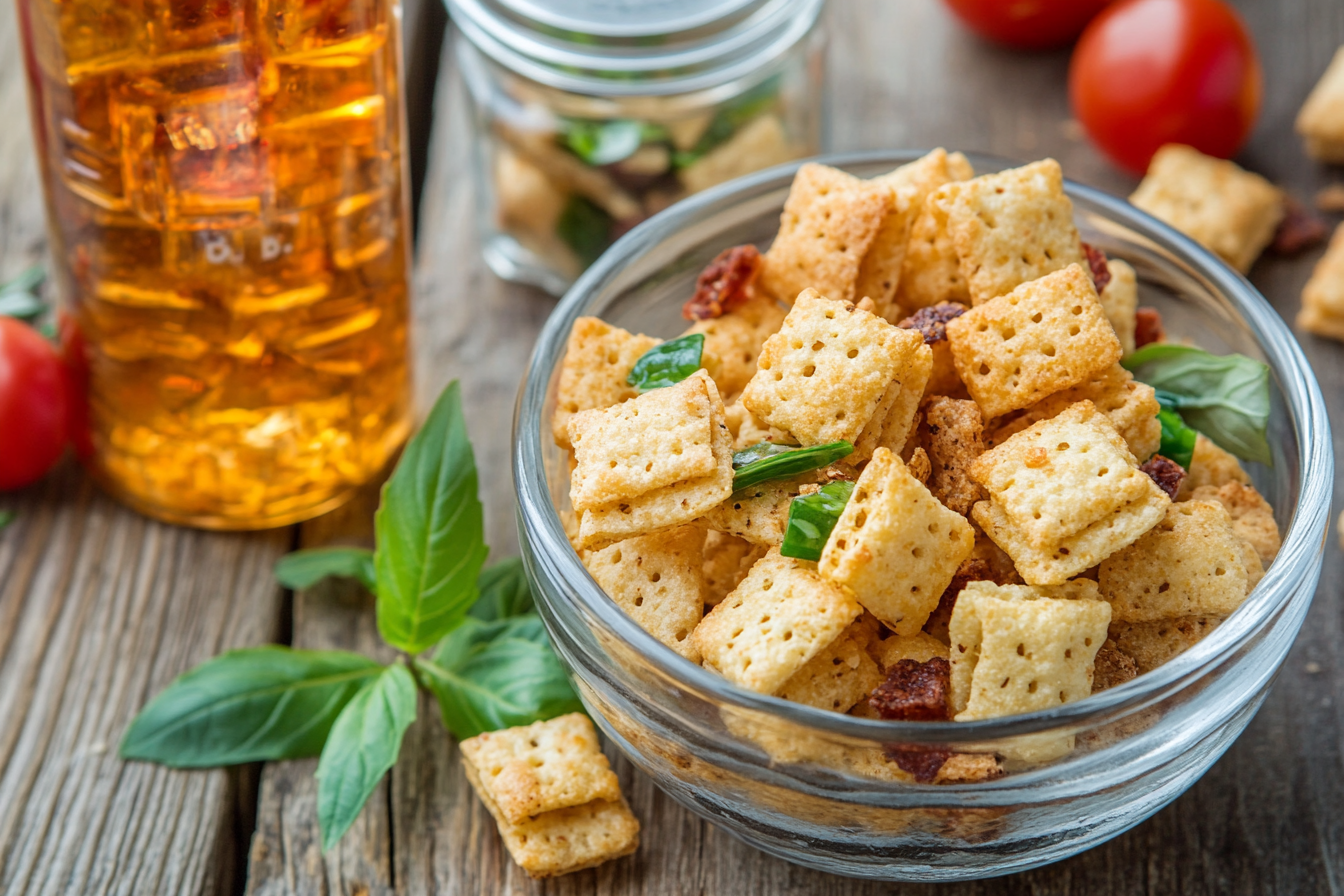Part 1: Introduction and Overview
Chex Mix snack : Understanding the Cost Dynamics
When deciding between buying store-bought DIY snack or making your own, the cost often becomes the focal point. Chex Mix, with its irresistible crunch and savory flavors, is a staple snack for many. But does convenience trump the cost-saving potential of homemade Chex Mix snack? This article dives deep into the pricing dynamics, flavor options, and overall practicality of each choice.

What is Chex Mix snack?
DIY snack is a savory snack blend made primarily from cereals, pretzels, nuts, and a mix of seasonings. The combination of textures and flavors has made it a favorite for everything from casual munching to party snacks. Over the years, its popularity has grown exponentially, with store shelves boasting various pre-packaged flavors, from Traditional to Bold and Cheddar. But while buying a bag is simple, many wonder if the homemade alternative provides better value.
Why People Debate Buying vs Making Chex Mix
The core debate centers around cost, convenience, and quality. Store-bought DIY snack comes ready to eat, saving time and effort. However, it can be pricier per serving, particularly for premium flavors or brands. Homemade DIY snack, on the other hand, requires purchasing multiple ingredients and dedicating time to preparation. Understanding the key factors—pricing, batch size, ingredient quality, and time—helps clarify which option works best for your budget and preferences.
Store-Bought Chex Mix
- Pricing Trends: On average, a 15 oz bag of DIY snack costs between $3.50 and $5.00, depending on the flavor and store.
- Variations in Prices: Popular flavors like Traditional or Bold tend to be cheaper, whereas limited-edition or gourmet versions cost more. Stores like Walmart and Target often provide discounts on multipacks, whereas convenience stores typically have higher prices.
Homemade Chex Mix
Making Chex Mix at home involves purchasing several key ingredients:
- Cereal Bases: Chex cereal varieties (corn, rice, wheat).
- Add-Ons: Pretzels, peanuts, bagel chips, and optional items like M&Ms or raisins.
- Seasonings: Worcestershire sauce, garlic powder, onion powder, and butter.
The preparation process is straightforward: combine the ingredients, mix with the seasoning blend, and bake. Homemade DIY snack allows for complete customization, whether you’re catering to dietary restrictions or flavor preferences.
Importance of Cost Analysis
Comparing store-bought to homemade Chex Mix boils down to balancing cost, convenience, and customization. Store-bought offers unparalleled ease, while homemade ensures greater control over ingredient quality and quantity. Analyzing the cost breakdown for both options highlights which path might be more economical for different scenarios.
Part 2: Detailed Cost Analysis
Breaking Down the Costs
To determine if it’s cheaper to buy DIY snack or make your own, you need to break down the associated costs:
- Store-Bought Chex Mix:
- Prices typically range between $3.50 and $5.00 for a standard 15 oz bag, depending on brand and retailer.
- Sale prices and bulk packs (e.g., from warehouse stores like Costco) might reduce the cost per ounce.
- Homemade Chex Mix:
- The cost depends on the ingredients you buy, the batch size, and whether you already have pantry staples like butter and spices.
- A basic batch requires cereals (Corn, Rice, and Wheat Chex), pretzels, peanuts, Worcestershire sauce, and spices. Let’s estimate the breakdown further.
Ingredient Cost Analysis
Homemade Chex Mix involves combining multiple ingredients. Here’s a closer look:
- Cereal Bases:
- A box of Chex cereal (12–14 oz) costs about $3.50–$4.00. You’ll need two or three varieties for an authentic mix, totaling $10–$12.
- Pretzels and Add-Ons:
- A bag of pretzels (16 oz): $2–$3.
- Peanuts (16 oz): $3–$5.
- Optional add-ons (e.g., M&Ms, raisins): $2–$4 per item.
- Seasonings:
- Worcestershire sauce, butter, garlic powder, onion powder: $3–$5 (if not already available in your pantry).
Estimated Total for Ingredients (Single Batch): $18–$25 upfront for ingredients, which yields about three times the volume of a 15 oz bag of store-bought DIY snack. That’s roughly $6–$8 per 15 oz serving.
Batch Size Comparison
Store-Bought Chex Mix:
- One bag (~15 oz) serves 8–10 people.
- Larger multipacks may lower costs but limit flavor flexibility.
Homemade Chex Mix:
- A single batch can easily double or triple the quantity of a store-bought bag.
- Cost per serving decreases as batch size increases.
Key Insight: If you consume Chex Mix frequently or need a large quantity (e.g., for parties), homemade offers significant cost savings.

Labor and Time Considerations
Making Chex Mix involves several steps:
- Measuring ingredients.
- Mixing seasoning and tossing ingredients.
- Baking (1 hour with stirring every 15 minutes).
Valuing Time:
- Preparing Chex Mix takes about 90 minutes, including cooling time.
- If you value your time at $15/hour, the “labor cost” adds ~$22.50 to your homemade batch.
Conversely, store-bought DIY snack eliminates prep time, offering immediate convenience.
Quality vs. Quantity
- Ingredient Quality:
- Store-bought Chex Mix often contains preservatives and artificial flavors, which may appeal less to health-conscious consumers.
- Homemade Chex Mix allows for fresh, high-quality ingredients tailored to preferences, such as organic cereals or low-sodium pretzels.
- Quantity Control:
- Homemade batches provide flexibility, letting you scale up or down depending on your needs.
Trade-Off: Store-bought delivers consistent quality and portion control, while homemade excels in customization and freshness.
Hidden Costs
Shelf Life and Storage:
- Store-Bought:
- Pre-packaged Chex Mix has a long shelf life due to preservatives, reducing the risk of waste.
- Homemade:
- Homemade versions lack preservatives and last about 1–2 weeks in an airtight container. Larger batches may risk spoilage if not consumed quickly.
Food Waste:
- Unused ingredients (e.g., half a box of Chex or leftover peanuts) from homemade recipes might go to waste if not utilized for other purposes.
Part 3: Other Considerations and Conclusion
Health and Nutrition Factors
Nutritional Value of Store-Bought vs Homemade Chex Mix
When comparing store-bought DIY snack with its homemade counterpart, health-conscious consumers often focus on nutritional value. Pre-packaged DIY snackfrequently contains:
- Preservatives: To extend shelf life, which can be less appealing for those avoiding processed foods.
- Sodium Levels: A standard serving (1 oz) can have up to 200–300 mg of sodium, which may not suit low-sodium diets.
- Added Sugars: Sweet varieties, such as Honey Nut or Muddy Buddies, are significantly higher in sugar.
In contrast, homemade DIY snack offers flexibility to adjust seasoning levels, swap ingredients, or use alternative seasonings like low-sodium soy sauce or olive oil.
Managing Dietary Restrictions with Homemade Chex Mix
Homemade Chex Mix allows customization for dietary needs:
- Allergies: Substitute peanuts with almonds, sunflower seeds, or omit nuts entirely.
- Gluten-Free Options: Use certified gluten-free Chex cereal and gluten-free pretzels.
- Healthier Fats: Replace butter with plant-based alternatives for vegan versions.
Customization Benefits
Flexibility with Flavors and Ingredients
Homemade Chex Mix provides creative freedom that store-bought versions lack. For example:
- Flavor Tweaks: Add cayenne pepper for heat or cinnamon for a sweet touch.
- Ingredient Swaps: Include healthier choices like dried fruit, whole-grain cereals, or dark chocolate chips.
Tailoring to Family or Event Needs
Homemade Chex Mix shines during special occasions. For instance:
- Game Days: Add cheese-flavored popcorn for a sports-themed mix.
- Holidays: Create festive versions with red and green candies or peppermint pieces.
Customizing for events can elevate the appeal while maintaining control over the cost.
Sustainability and Eco-Friendliness
Packaging Waste in Store-Bought Chex Mix
Pre-packaged Chex Mix contributes to single-use plastic waste, an increasing concern for eco-conscious shoppers. While some brands attempt to use recyclable materials, the majority of snack bags end up in landfills.
Reducing Waste with Homemade Options
Homemade Chex Mix allows you to buy ingredients in bulk, reducing packaging waste significantly. Leftover ingredients can also be repurposed, minimizing food waste.
Practical Scenarios
When to Opt for Store-Bought
- Convenience: Store-bought is ideal for busy schedules or last-minute needs.
- Portability: Packaged Chex Mix is easy to grab-and-go, making it perfect for road trips or office snacks.
- Storage: Its longer shelf life ensures less frequent replenishing.
Best Occasions for Making Chex Mix
- Large Gatherings: Parties, potlucks, or holiday events benefit from the cost savings of homemade Chex Mix.
- Themed Variations: Custom flavors tailored to specific events create a unique experience.
Taste and Texture
Comparing Flavor Profiles
- Store-bought DIY snackx Mix offers a predictable, balanced flavor, but some find it lacks the depth or boldness that homemade versions can provide.
- Homemade allows for stronger or milder seasoning, catering to personal taste preferences.
Balancing Crunchiness and Freshness
- Store-bought DIY snack retains its crunch for weeks, thanks to preservatives.
- Homemade DIY snack, while fresher, can lose its crunch if not stored properly.
Survey of Consumer Preferences
Online forums and consumer reviews reveal varied preferences:
- Convenience Fans: Prefer store-bought for ease and time savings.
- Homemade Advocates: Value the customization, freshness, and cost-effectiveness of DIY Chex Mix.
Notably, trends show an increasing interest in homemade snacks due to health concerns and rising packaged food prices.

Final Cost Comparison Summary
| Category | Store-Bought | Homemade |
|---|---|---|
| Cost per 15 oz Serving | $3.50–$5.00 | ~$6.00–$8.00 |
| Batch Size | Fixed (15 oz) | Flexible (up to 45 oz) |
| Prep Time | None | ~90 minutes |
| Customization | Limited | Unlimited |
| Shelf Life | Longer | Shorter (1–2 weeks) |
Key Takeaways from the Analysis
- Cheaper Option: Store-bought Chex Mix is generally cheaper for small servings or infrequent use.
- Best Value: Homemade DIY snack provides significant savings when scaled for large batches.
- Customization Advantage: Homemade excels in flexibility and quality control.
- Convenience Factor: Store-bought wins in time efficiency and portability.
Conclusion
So, is it cheaper to buy Chex Mix or make your own? The answer depends on your priorities. For single servings or busy schedules, store-bought DIY snack is a quick and cost-effective solution. However, if you’re hosting a party or seeking customizable flavors, making Chex Mix at home provides better value and creative freedom.
Balancing cost, convenience, and taste is the key to deciding which option suits your needs. Ultimately, the choice comes down to whether you prioritize saving money or saving time.
More FAQs
- Can I freeze homemade Chex Mix to extend its shelf life?
Yes, freezing in an airtight container can keep it fresh for up to 3 months. - What’s the cheapest place to buy Chex cereal?
Grocery stores like Walmart or online platforms like Amazon often have competitive prices. - How can I make a low-sodium version of DIY snack?
Use unsalted butter, low-sodium pretzels, and omit added salt in the seasoning mix. - Is it worth making Chex Mix for a single person?
Smaller homemade batches can still be cost-effective and tailored to your taste. - Are there vegan-friendly Chex Mix recipes?
Yes, substitute butter with vegan margarine and avoid dairy-based add-ons. - What’s the most popular store-bought Chex Mix flavor?
Traditional and Bold Party Blend are fan favorites. - How do I prevent homemade DIY snack from going stale?
Store it in an airtight container and avoid humidity. - Can I use a microwave instead of an oven to make DIY snack?
Yes, microwave recipes are quicker but may yield less even crunch. - Are there gluten-free DIY snack options in stores?
Yes, some brands offer gluten-free versions, or you can make your own with certified gluten-free ingredients. - What’s the best seasoning substitute for Worcestershire sauce?
Soy sauce or tamari can work as an alternative, depending on dietary needs.

